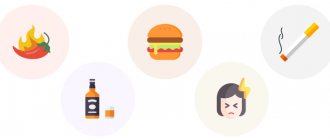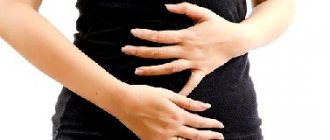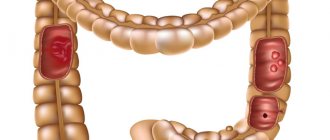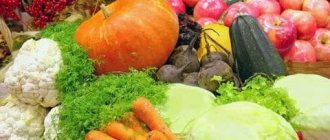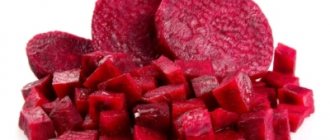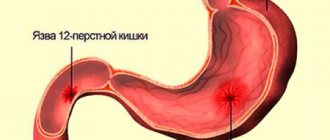General rules
The initial part of the duodenum, adjacent to the sphincter of the pyloric part of the stomach, is called the bulb.
The acidic contents of the stomach enter the bulb and begin to bring its pH to alkaline, which does not irritate the underlying parts of the small intestine. The duct of the pancreas and gall bladder opens in the bulb and digestive enzymes begin to operate. Inflammation of the mucous membrane of the bulb is called bulbitis . Gastritis often interrelated processes, and therefore the term gastric bulbitis is often used, which is incorrect from an anatomical point of view. Bulbit refers only to the duodenal bulb. The acute form of the disease can be caused by poisoning, consumption of alcohol and its surrogates, and use of medications. The main cause of the chronic form is Helicobacter pylori infection, giardiasis , helminthic infestations and Crohn's disease .
Helicobacter pylori infection against the background of poor nutrition (irregular intake, excess spicy foods in the diet) and prolonged stress (activates acid formation in the stomach) causes dysfunction of the duodenum and inflammation. Brunner's duodenal glands, which normally produce an alkalizing secretion that neutralizes stomach acid, are damaged. The resulting duodenogastric reflux (bile enters the stomach through the bulb) against this background further reduces the protective barrier of the mucous layer and maintains constant irritation and inflammation of the mucosa.
According to gastroduodenoscopy, inflammation can be: catarrhal (simple inflammation), and erosive, when surface defects appear on the mucous membrane - erosions, which can be accompanied by bleeding (hemorrhagic variant of the disease).
The most characteristic is aching pain in the epigastric region and in the right hypochondrium, occurring 1-2 hours after eating. At the initial stage of the disease, loss of appetite, heartburn, belching, flatulence appear. Erosive bulbitis often manifests itself as burning pain radiating to the back, and it occurs at night or on an empty stomach. The appearance of bitter belching and vomiting with the presence of bile indicates the reflux of intestinal contents back into the stomach. During an exacerbation, patients experience increased fatigue, malaise, sweating and other autonomic disorders.
In the treatment of the disease, proper nutrition is of no small importance. The diet for erosive duodenal bulbitis is prescribed the same as for peptic ulcer disease and depends on the stage of the disease (exacerbation or attenuation of the process). Most often, patients with this pathology have increased acidity, so during an exacerbation, Diets No. 1A and No. 1B , which are prescribed sequentially. , Diet No. 1 may be recommended . Table No. 2 may be recommended .
During the period of exacerbation, bulbitis of the duodenum occurs with severe pain and dyspeptic disorders, so it is necessary to create rest for the gastrointestinal tract with the most gentle nutrition. In such cases Diet No. 1A , which maximally limits all effects of food on the mucous membrane and creates all the conditions to reduce inflammation and restore the mucous membrane. This is especially important in the presence of erosions.
The diet is recommended for the first days of treatment while the patient is on bed rest. Reducing the amount of protein and fat, limiting carbohydrates and salt, certain methods of cooking and its liquid consistency - all this spares the mucous membrane as much as possible. Such nutrition can be prescribed (depending on the severity of the disease) for 5-14 days.
Nutritional features at this moment:
- Eating food only pureed and in a liquid or mushy state.
- Any broths (food is cooked in water) and mucosal irritants (any vegetables and coarse cereals) are excluded.
- Avoid foods that are difficult to digest (legumes, mushrooms, tough meat, fish and chicken skin, even pureed).
- Cold and hot dishes are not allowed, as they irritate the mucous membrane and slow down its recovery.
- 6 meals a day are provided and the amount of food per meal is limited, which also reduces inflammation.
This diet allows:
- Slimy soups - they are strained decoctions of cereals (semolina, rice, oatmeal), and the cereals themselves are not consumed. Butter and whipped egg-milk mixture are added to such soups.
- All meat and fish products are thoroughly beaten in a blender or passed through a meat grinder several times. Steam soufflés or pates are prepared from minced meat.
- Steam soufflé made from pureed non-acidic cottage cheese (preferably calcined), milk and cream. Any fermented milk drinks are not allowed.
- Steam omelette made from whole eggs.
- Liquid porridge made from cereal flour (buckwheat, rice, oatmeal), cooked in water or with the addition of milk. You can also eat pureed porridge from boiled cereals, but dilute them greatly with water, milk or cream. Butter should be added to prepared porridges.
- Kissels made from sweet berries (they are pureed), the use of fruit jelly and honey, diluted fruit juices is allowed.
- Drinks include weak tea with milk, bran decoction, rosehip infusion.
In the stage of calming down of the process or immediately, if the exacerbation is not expressed, patients are prescribed loading Diet No. 1B . It has significantly fewer restrictions, the amount of basic food components and calorie content has been increased, but the salt restriction remains. The diet is balanced and the timing of its observance is individual (10-30 days). You can already eat white bread croutons, pureed soups and pureed cereals, canned vegetable and fruit baby food are introduced. Fish and meat dishes are still recommended in the form of minced meat, soufflé, quenelles, cutlets or puree.
After this, the main Table No. 1 , and in case of mild exacerbation it is prescribed immediately. This is a moderately gentle and complete diet in terms of protein, fat and carbohydrates and can be followed for a long time. It is advisable to limit the amount of salt.
- Indigestible, coarse foods, secretion agents and dishes with an irritating effect are excluded: stringy meat, wholemeal bread, poultry skin and fish, mushrooms, turnips, radishes, asparagus, radishes, legumes, white cabbage, fruits with rough skin (grapes, currants, gooseberries, dates), mustard, horseradish, hot sauces, etc.
- The diet is divided into small portions, you cannot take long breaks (4 hours) between meals, and it is also recommended to chew it thoroughly.
- Dishes are prepared boiled and occasionally baked; more often they are pureed, but fish and tender meat can be eaten in pieces.
In this way, the patient gradually prepares for the transition to a common table. But even if you feel well in a state of remission, it is not advisable to consume large amounts of spices and herbs, spicy foods, smoked foods, fatty and fried foods. The diet should also limit legumes, coarse fiber and carbohydrates - foods that cause fermentation and putrefaction in the intestines. Below are permitted and prohibited foods, menus and recipes for Diet No. 1 .
Folk remedies in the fight against bulbitis
In addition to medication and diet, doctors recommend folk remedies, especially during exacerbations.
There are a lot of recipes, tinctures and decoctions that provide effective treatment for bulbitis. Here are some of them:
- A decoction of plantain, chamomile, St. John's wort, licorice root, and Icelandic moss. To prepare the decoction, mix the ingredients in equal proportions, take 2 tbsp. mixture and pour 400 ml. boiling water Leave for an hour. Take 100 ml. three times a day before meals.
- Decoction of oak bark. The decoction is prepared in a thermos. You should take 1 tsp. oak bark, add 200 ml. boiling water, then shake and close. Leave the infusion overnight. Take 5 times a day, 1 tbsp. before eating.
- Honey and plantain juice. Grind a small bunch of plantain leaves into a pulp, strain the resulting substance through cheesecloth. Collect the juice in a container. After this, select 3 tbsp. juice and add 1 tbsp. liquid honey, dilute the mixture with a small amount of water. Drink the resulting mixture 50 ml. before every meal.
- Propolis tincture. You need to take 60 grams. propolis and 250 ml. alcohol Mix the ingredients and let it brew for 7 days. The tincture should be consumed as follows: 5 ml. dilute the prepared solution with 150 ml. boiled water, take in small sips.
Decoctions and tinctures made according to folk recipes are taken for 2-3 weeks.
Authorized Products
- Soups are prepared with vegetable broth (all broths, cabbage soup, okroshka and borscht are excluded). Soups should contain well-cooked or pureed cereals and finely chopped or pureed vegetables.
- It is allowed to introduce an egg-milk mixture, season soups with cream and butter.
- You can only eat dried wheat bread (highest grade).
- Chopped steamed dishes (meatballs, pate cutlets, meatballs) are prepared from lean meat (beef, lamb, pork, turkey, chicken). Soft meat can be cooked in pieces, or boiled tongue can be eaten.
- Lean fish is prepared in the same way - chopped or in pieces, but without skin. Jellied fish in vegetable broth is allowed.
- Dairy products are represented by cream, milk, cottage cheese, yogurt and non-acidic kefir. Souffles, lazy dumplings and cottage cheese casseroles are prepared from cottage cheese.
- From semolina, buckwheat and rice cereals, pureed porridge of a semi-viscous consistency is prepared in water or milk.
- Butter and vegetable oil are added to ready-made first courses and porridges.
- Vegetables allowed include potatoes, cauliflower, carrots and beets. They are steamed and served as purees and steamed puddings.
- You can drink weak tea with added cream or milk, sweet juices, jelly. The use of jellies and fruit purees is allowed, and compotes only with pureed fruit. Sugar and honey are added to dishes.
Table of permitted products
| Proteins, g | Fats, g | Carbohydrates, g | Calories, kcal | |
Vegetables and greens | ||||
| cauliflower | 2,5 | 0,3 | 5,4 | 30 |
| potato | 2,0 | 0,4 | 18,1 | 80 |
| carrot | 1,3 | 0,1 | 6,9 | 32 |
| beet | 1,5 | 0,1 | 8,8 | 40 |
Cereals and porridges | ||||
| buckwheat (kernel) | 12,6 | 3,3 | 62,1 | 313 |
| semolina | 10,3 | 1,0 | 73,3 | 328 |
| cereals | 11,9 | 7,2 | 69,3 | 366 |
| white rice | 6,7 | 0,7 | 78,9 | 344 |
Bakery products | ||||
| white bread crackers | 11,2 | 1,4 | 72,2 | 331 |
| wheat bread | 8,1 | 1,0 | 48,8 | 242 |
Confectionery | ||||
| jelly | 2,7 | 0,0 | 17,9 | 79 |
Raw materials and seasonings | ||||
| sugar | 0,0 | 0,0 | 99,7 | 398 |
Dairy | ||||
| milk | 3,2 | 3,6 | 4,8 | 64 |
| kefir | 3,4 | 2,0 | 4,7 | 51 |
| cream | 2,8 | 20,0 | 3,7 | 205 |
| curdled milk | 2,9 | 2,5 | 4,1 | 53 |
Cheeses and cottage cheese | ||||
| cottage cheese | 17,2 | 5,0 | 1,8 | 121 |
Meat products | ||||
| boiled beef | 25,8 | 16,8 | 0,0 | 254 |
| boiled veal | 30,7 | 0,9 | 0,0 | 131 |
| rabbit | 21,0 | 8,0 | 0,0 | 156 |
Bird | ||||
| boiled chicken | 25,2 | 7,4 | 0,0 | 170 |
| turkey | 19,2 | 0,7 | 0,0 | 84 |
Eggs | ||||
| chicken eggs | 12,7 | 10,9 | 0,7 | 157 |
Oils and fats | ||||
| butter | 0,5 | 82,5 | 0,8 | 748 |
Non-alcoholic drinks | ||||
| mineral water | 0,0 | 0,0 | 0,0 | — |
| black tea with milk and sugar | 0,7 | 0,8 | 8,2 | 43 |
Juices and compotes | ||||
| juice | 0,3 | 0,1 | 9,2 | 40 |
| jelly | 0,2 | 0,0 | 16,7 | 68 |
| rose hip juice | 0,1 | 0,0 | 17,6 | 70 |
| * data is per 100 g of product | ||||
Herbal decoctions of traditional medicine for the diet
In order for a diet for erosive bulbitis to bring maximum effect, it is recommended to use alternative medicine as diet drinks. Herbal medicines promote the healing of affected tissues, relieve inflammation of the mucous membrane, and relieve pain.
The greatest benefit in a diet for erosive bulbitis will come from herbs that have analgesic and anti-inflammatory properties. Most often, rose hips, chamomile flowers, St. John's wort, yarrow and plantain herbs are used to prepare rich drinks.
It is first recommended to make sure that there is no negative reaction to herbal ingredients - to monitor the well-being and general condition of the body after the first doses. If you are concerned about side effects (headaches, unpleasant discomfort in the digestive organs, nausea or vomiting), immediately stop using homemade herbal remedies.
The diet for bulbitis should be supplemented with the following folk remedies:
- plantain juice. Collect young leaves of the plant, chop (use a blender or simply chop the greens with a sharp knife). Rub with your hands and leave for half an hour. After the juice has formed, strain (use gauze or a special strainer). Use immediately - during storage, the beneficial qualities of the drink rapidly decrease. The recommended dosage for administration is 50 ml. Take plantain juice no more than twice a day, preferably between main meals;
- carrot juice. Rinse the root vegetables thoroughly (bright orange vegetables are considered the healthiest) and grate them on a fine grater. Squeeze out the liquid and consume immediately after preparation. Drink 100–120 ml juice before each meal;
- St. John's wort decoction. Place dry herb (15 grams) in a brewing container. Boil water (500 ml), steam the plant material. Close the container tightly and let it brew (to concentrate the beneficial elements, it is recommended to wrap the infuser with a terry towel or a warm scarf). Strain after half an hour. It is allowed to add a little sugar, especially if the liquid has a bitter taste.
Regardless of the chosen home remedy in the diet for gastric bulbitis, it is not recommended to take decoctions or juice regularly. The optimal treatment option is to drink the product for two weeks, take a break and allow the body to rest for 7-10 days.
Diet for bulbitis is an obligatory stage of successful treatment, which should not be neglected, otherwise even powerful medications will be ineffective. It is better to discuss the diet menu for bulbitis, even if there is the slightest doubt, with a nutritionist who will select the most beneficial combinations of products for the digestive organs, help make a list of prohibited dishes, and recommend auxiliary measures.
Fully or partially limited products
- Fermented milk products with high acidity.
- Dishes that stimulate secretions and irritate the mucous membranes are excluded: meat/fish broths, mushrooms, fried and stewed dishes, hot and sour sauces, broth-based sauces, smoked meat and fish products, pickles and pickled vegetables, canned food, spices and seasonings (horseradish, mustard, mayonnaise).
- Rye bread, any fresh bread, confectionery products made from puff pastry.
- Millet, pearl barley, barley and corn cereals, pasta, legumes.
- White cabbage, radish, sorrel, cucumbers, tomatoes, onions.
- Sour and coarse fiber fruits/berries.
Table of prohibited products
| Proteins, g | Fats, g | Carbohydrates, g | Calories, kcal | |
Vegetables and greens | ||||
| spicy vegetables | 2,8 | 0,5 | 5,3 | 36 |
| vegetables legumes | 9,1 | 1,6 | 27,0 | 168 |
| canned vegetables | 1,5 | 0,2 | 5,5 | 30 |
| stewed vegetables (fried) | 2,0 | 6,8 | 8,0 | 106 |
| daikon | 1,2 | 0,0 | 4,1 | 21 |
| cabbage | 1,8 | 0,1 | 4,7 | 27 |
| cucumbers | 0,8 | 0,1 | 2,8 | 15 |
| radish | 1,2 | 0,1 | 3,4 | 19 |
| white radish | 1,4 | 0,0 | 4,1 | 21 |
| turnip | 1,5 | 0,1 | 6,2 | 30 |
| horseradish | 3,2 | 0,4 | 10,5 | 56 |
| garlic | 6,5 | 0,5 | 29,9 | 143 |
| sorrel | 1,5 | 0,3 | 2,9 | 19 |
Mushrooms | ||||
| mushrooms | 3,5 | 2,0 | 2,5 | 30 |
Cereals and porridges | ||||
| corn grits | 8,3 | 1,2 | 75,0 | 337 |
| pearl barley | 9,3 | 1,1 | 73,7 | 320 |
| wheat bran | 15,1 | 3,8 | 53,6 | 296 |
| millet cereal | 11,5 | 3,3 | 69,3 | 348 |
| barley grits | 10,4 | 1,3 | 66,3 | 324 |
Flour and pasta | ||||
| pasta | 10,4 | 1,1 | 69,7 | 337 |
Bakery products | ||||
| oatmeal bread | 10,1 | 5,4 | 49,0 | 289 |
| Rye bread | 6,6 | 1,2 | 34,2 | 165 |
| bran bread | 7,5 | 1,3 | 45,2 | 227 |
| doctor's bread | 8,2 | 2,6 | 46,3 | 242 |
| whole grain bread | 10,1 | 2,3 | 57,1 | 295 |
Confectionery | ||||
| jam | 0,3 | 0,2 | 63,0 | 263 |
| candies | 4,3 | 19,8 | 67,5 | 453 |
| pastry cream | 0,2 | 26,0 | 16,5 | 300 |
| butter cookies | 10,4 | 5,2 | 76,8 | 458 |
Ice cream | ||||
| ice cream | 3,7 | 6,9 | 22,1 | 189 |
Cakes | ||||
| cake | 4,4 | 23,4 | 45,2 | 407 |
Chocolate | ||||
| chocolate | 5,4 | 35,3 | 56,5 | 544 |
Raw materials and seasonings | ||||
| mustard | 5,7 | 6,4 | 22,0 | 162 |
| ketchup | 1,8 | 1,0 | 22,2 | 93 |
| mayonnaise | 2,4 | 67,0 | 3,9 | 627 |
| ground black pepper | 10,4 | 3,3 | 38,7 | 251 |
| chilli | 2,0 | 0,2 | 9,5 | 40 |
Meat products | ||||
| pork | 16,0 | 21,6 | 0,0 | 259 |
Sausages | ||||
| dry-cured sausage | 24,1 | 38,3 | 1,0 | 455 |
| sausages | 12,3 | 25,3 | 0,0 | 277 |
Bird | ||||
| smoked chicken | 27,5 | 8,2 | 0,0 | 184 |
| duck | 16,5 | 61,2 | 0,0 | 346 |
| smoked duck | 19,0 | 28,4 | 0,0 | 337 |
| goose | 16,1 | 33,3 | 0,0 | 364 |
Fish and seafood | ||||
| dried fish | 17,5 | 4,6 | 0,0 | 139 |
| smoked fish | 26,8 | 9,9 | 0,0 | 196 |
| canned fish | 17,5 | 2,0 | 0,0 | 88 |
Oils and fats | ||||
| creamy margarine | 0,5 | 82,0 | 0,0 | 745 |
| animal fat | 0,0 | 99,7 | 0,0 | 897 |
| cooking fat | 0,0 | 99,7 | 0,0 | 897 |
Non-alcoholic drinks | ||||
| black tea | 20,0 | 5,1 | 6,9 | 152 |
| * data is per 100 g of product | ||||
Menu for erosive bulbitis (Diet mode)
Alternating different protein and cereal dishes will make your diet varied. The additional introduction of baking also diversifies the diet. Meat or fish dishes are consumed 2 times a day, plus the protein part of the diet is supplemented with cottage cheese, eggs, milk and non-acidic kefir. At night, it is preferable to consume cream or milk, and if whole milk is poorly tolerated, you should give preference to non-acidic kefir or yogurt.
| Breakfast |
|
| Lunch |
|
| Dinner |
|
| Afternoon snack |
|
| Dinner |
|
| For the night |
|
| Breakfast |
|
| Lunch |
|
| Dinner |
|
| Afternoon snack |
|
| Dinner |
|
| For the night |
|
| Breakfast |
|
| Lunch |
|
| Dinner |
|
| Afternoon snack |
|
| Dinner |
|
| For the night |
|
Recipes
When preparing dietary dishes, you must follow certain rules. When steaming, food should not come into contact with liquid, but should be treated with boiling steam. The loss of all substances in this case is less than during cooking. Omelettes or egg porridge must be cooked in a water bath - the container with the product is placed in another larger one filled with water.
The use of cereal flour (rice, buckwheat or oatmeal) will speed up the cooking process. In a blender you can easily and quickly puree boiled meat and vegetables. This diet involves the preparation of cream soups and puree soups. They are prepared from various vegetables, as well as a mixture of vegetables and cereals; you can add rolled boiled chicken meat. All products are first boiled, pureed or whipped with a blender and the resulting thick mass is diluted with vegetable broth if you are preparing a puree soup, or with milk and cream if you want to get a cream soup. Add a piece of butter to prepared dishes.
First meal
Puree rice soup with meat
Boil chicken or beef and blend in a blender. Cook the rice until fully cooked and also grind in a blender or puree. Add meat to the pureed rice, add water to the desired consistency and boil. Add a piece of butter.
Oatmeal soup with zucchini (grated)
Boil the peeled zucchini and drain the vegetable broth. Boil oatmeal or flakes well. Grate the zucchini and cereal, dilute with vegetable broth, bring to a boil and add salt. Add butter to the finished soup. Serve with croutons.
Second courses
Egg porridge
Beat eggs with milk, add salt and butter. The whipped mass is poured into a mold, which is placed in a container with hot water. Cook while stirring until it reaches the consistency of porridge. There is another cooking option. The prepared egg mass is poured into a saucepan with water (a small amount is needed) and cooked like porridge, stirring and bringing until thickened. Excess water needs to be drained.
Steamed chicken cutlets
Cutlets are made from raw chicken or turkey. Choose meat without tendons and skin (the ideal option is breast). The meat is twisted several times or beaten using a blender, soft butter, milk, salt, and beaten egg whites are added, small cutlets are formed and steamed for 20-25 minutes.
Dessert
Curd soufflé
The cottage cheese needs to be rubbed well, add the yolk, milk, a little flour and sugar. Beat the whites until foamy and fold into the curd mixture. Steam in any form. Can be served with fruit jelly or condensed milk.
Raspberry jelly
Boil raspberries or other sweet berries for 2-3 minutes, adding a little water. Rub through a sieve. Add sugar to taste to the resulting thick mass, boil a little and add dissolved gelatin. If you want to get the effect of a light, “quivering” jelly, take 10 g of gelatin per 500 ml of liquid portion. Stir thoroughly and pour into molds.
Causes of the disease
Bulbit occurs due to Helicobacter pylori infection.
With increased acidity, a favorable environment is created for the colonization of bacteria of this infection. They feel comfortable in this environment, creating a protective alkaline barrier around themselves.
Substances that cause an inflammatory process are produced, which destroys the mucous membrane.
As a result, erosive bulbitis develops, and if left untreated, ulcers appear. Only diet can alleviate symptoms and improve digestion.
This disease can occur for anatomical reasons. In this case, during embryonic development, the mesentery is preserved at the duodenum.
It looks like a loop in which highly acidic food coming from the stomach stagnates. Under these conditions, bacteria actively develop, which leads to the destruction of the mucous membrane.
One solution to this problem is a special diet.
Associated causes of the disease:
- Decreased immune system.
- Genetics.
- Poor nutrition.
- Other concomitant serious illnesses.
Reviews and results
Compared to the strict restriction of foods in Diets No. 1A and No. 1B , this table provides for a significant expansion of the list of permitted foods. In addition, an additional type of cooking (baking) also allows you to diversify your diet. The exclusion of baked goods and sweets is poorly tolerated by patients, so many patients reduce the time spent on a strict diet if their health allows this.
- “... The first time erosion was discovered, there was severe pain and nausea. He refused hospitalization. At home I followed a diet and took pills. After two weeks everything returned to normal, but I continued to do all this, and to make sure everything healed, I went for an examination only a month later. The treatment result was good, but there was still a month of diet and pills. Now I eat everything, but I try to avoid smoked and spicy foods, and, of course, alcohol”;
- “... I had everything: pyloritis and gurgling. Compliance with the diet, diet plus peace of mind is what is needed for treatment. And of course the pills prescribed by the doctor. At first, while I followed the diet from time to time (only when there was an exacerbation), and even my restless character, there were continuous relapses. Then I was treated in a hospital and decided to take charge of my health and monitor my diet. So a year passed without exacerbations, which made me very happy and inspired. Now I try not to eat fried foods, smoked sausages, I have forever given up vinegar, marinades, hot seasonings and spices. I feel good";
- “... I came to the conclusion that I personally need to constantly follow a diet. As soon as you relax a little and switch to a normal diet, belching, heartburn or stomach pain immediately appears. And this worries me almost constantly. The last time I was examined, they prescribed treatment for me and told me to improve my diet. I followed this diet for 3 months - I lost weight, there was no pain or heartburn. Of course, I’m tired of everything steamed and vegetables without seasoning to taste, but I have no other choice. Now I’m expanding my diet, but I’ll still leave the dishes boiled or baked in foil so there’s no crust.”
Prevention
Bulbit is often a consequence of gastritis. Therefore, to prevent inflammation of the duodenum. It is necessary to prevent gastritis. To do this you should:
- Healthy food;
- do not expose the body to excessive physical stress;
- avoid stress;
- lead a healthy lifestyle;
- do not overeat;
- control weight;
- get rid of bad habits;
- do not abuse spicy foods;
- move actively.
If the work is “sedentary”, then every day before going to bed you need to take walks in the fresh air. This will strengthen the nervous system, relieve emotional stress, increase peristalsis and improve sleep. You should also minimize your consumption of alcohol and fatty foods. Quick snacks and fast food should be completely avoided.
Preventive actions
If the diagnosis of gastritis is confirmed, qualified treatment of the disease should be immediately carried out. In this case, do not self-medicate, but consult a specialist, since the disease has several treatment options, depending on the form of the disease.
Helpful information. After treatment, tests are performed to determine the absence of Helicobacter pylori infection. Pathogenic microorganisms are a common cause of gastritis.
